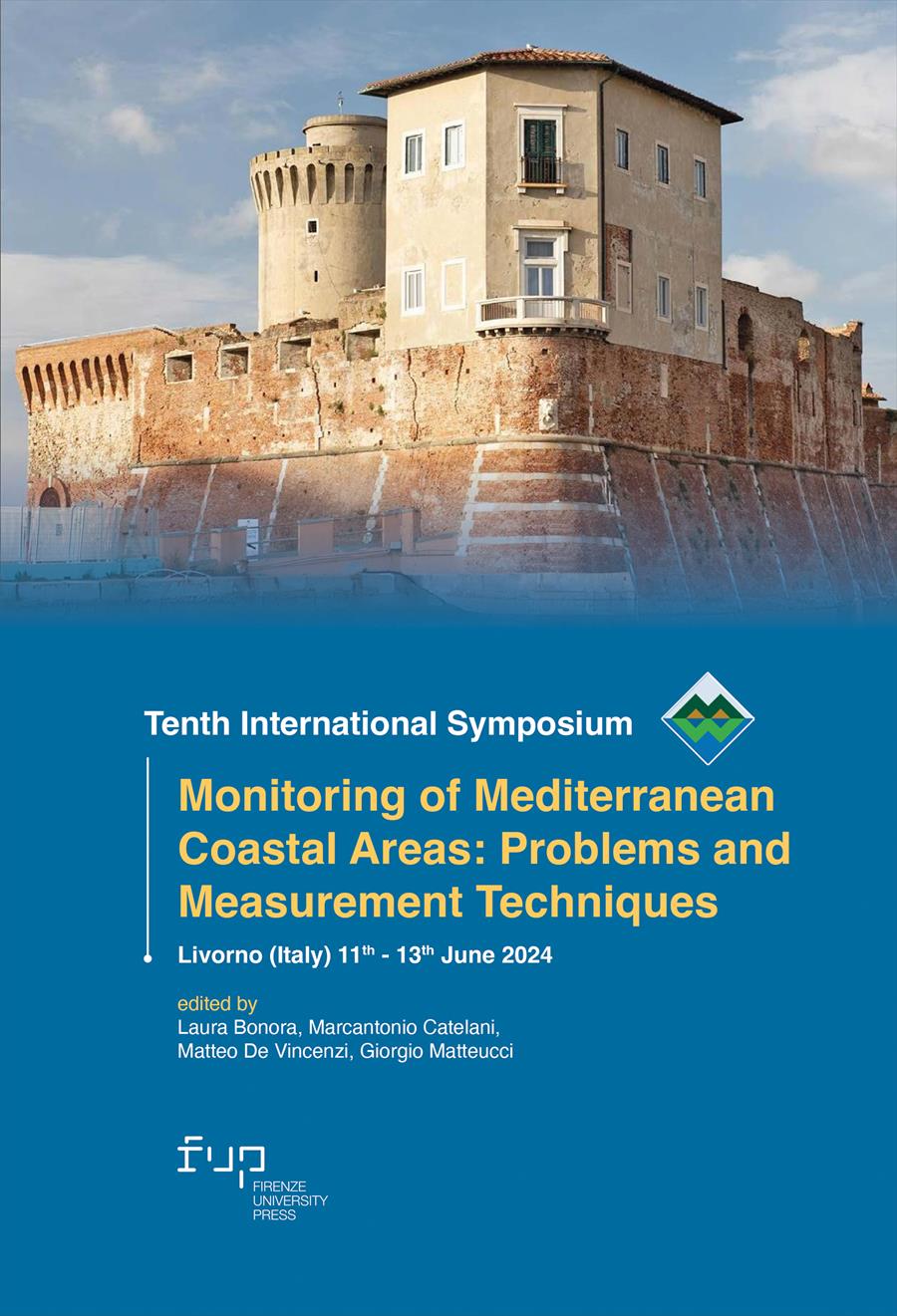- Tenth International Symposium "Monitoring of Mediterranean Coastal Areas: Problems and Measurement Techniques"
- Edited by Laura Bonora, Marcantonio Catelani, Matteo De Vincenzi, Giorgio Matteucci
Sea level rise projections: risk and impacts on populations in the mediterranean basin
- Federico Martellozzo
- Filippo Randelli
- Matteo Dalle Vaglie
- Carolina Falaguasta
- © 2024 Author(s) |
- CC BY-NC-SA 4.0
- DOI: 10.36253/979-12-215-0556-6.38
Extreme Sea Level Rise (ESLR) refers to the significant elevation in ocean levels driven by climate change and other anthropogenic and geophysical factors. This phenomenon poses a substantial threat to coastal populations, particularly as climate change accelerates the rate of sea level rise. Reducing greenhouse gas emissions and addressing climate change causes are essential to slowing ESLR and minimizing its impacts on coastal communities. However, achieving significant global reductions in GHG emissions is a complex, long-term endeavor. As a result, many coastal regions, and even some inland areas, will inevitably face the impacts of ESLR sooner or later, with certain areas being more vulnerable due to their land use and topography. Currently, numerous institutions have modelled ocean volume expansion at various geographical scales. This study aims to create geographically detailed datasets that depict the inland extent of ESLR impacts under future climate change conditions, focusing on the Atlantic coast of Europe and the Euro-Mediterranean basin. By integrating ESLR projections under IPCC 4.5 and 8.5 scenarios, our estimates reveal that ESLR poses a significant threat to coastal populations. The study identifies that between 2050 and 2100, ESLR could affect areas where millions reside, emphasizing the urgent need for adaptive strategies to protect vulnerable populations and mitigate the adverse effects of rising sea levels.
- Keywords:
- Extreme Sea Level Rise,
University of Florence, Italy - ORCID: 0000-0002-3142-2543
University of Florence, Italy - ORCID: 0000-0003-4669-5832
University of Florence, Italy - ORCID: 0009-0006-5323-5577
University of Florence, Italy - ORCID: 0009-0004-2847-6868
- Horton, B.P., Khan, N.S., Cahill, N. et al. (2020) Estimating global mean sea-level rise and its uncertainties by 2100 and 2300 from an expert survey. npj Clim Atmos Sci 3, 18. DOI: 10.1038/s41612-020-0121-5
- Taherkhani, M., Vitousek, S., Barnard, P.L. et al. (2020) Sea-level rise exponentially increases coastal flood frequency. Sci Rep 10, 6466. DOI: 10.1038/s41598-020-62188-4
- Becker, M., Karpytchev, M. & Hu, A. (2023) Increased exposure of coastal cities to sea-level rise due to internal climate variability. Nat. Clim. Chang. 13, 367–374. DOI: 10.1038/s41558-023-01603-w
- Conyers Z.A., Richard Grant & Shouraseni Sen Roy (2019) Sea Level Rise in Miami Beach: Vulnerability and Real Estate Exposure, The Professional Geographer, 71:2, 278-291, DOI: 10.1080/00330124.2018.1531037
- Marsooli, R., Lin, N. (2020) Impacts of climate change on hurricane flood hazards in Jamaica Bay, New York. Climatic Change 163, 2153–2171. DOI: 10.1007/s10584-020-02932-x
- Kirezci, E., Young, I.R., Ranasinghe, R. et al. (2020) Projections of global-scale extreme sea levels and resulting episodic coastal flooding over the 21st Century. Sci Rep 10, 11629. DOI: 10.1038/s41598-020-67736-6
- Dang, A.T.N., Reid, M. & Kumar, L. (2022). Assessing potential impacts of sea level rise on mangrove ecosystems in the Mekong Delta, Vietnam. Reg Environ Change 22, 70 DOI: 10.1007/s10113-022-01925-z
- Vousdoukas, M.; Mentaschi, L.; Voukouvalas, E.; Verlaan, M.; Jevrejeva, S.; Jackson, L.; Feyen, L. (2018): Global Extreme Sea Level projections. European Commission, Joint Research Centre (JRC) [Dataset] PID: http://data.europa.eu/89h/jrc-liscoast-10012 DOI: 10.2905/jrc-liscoast-10012
- Eini, M., Kaboli, H. S., Rashidian, M., & Hedayat, H. (2020). Hazard and vulnerability in urban flood risk mapping: Machine learning techniques and considering the role of urban districts. International Journal of Disaster Risk Reduction, 50, 101687; DOI: 10.1016/j.ijdrr.2020.101687
- Alfieri, L., Bisselink, B., Dottori, F., Naumann, G., De Roo, A., Salamon, P., ... & Feyen, L. (2017). Global projections of river flood risk in a warmer world, Earth’s Future, 5, 171–182; DOI: 10.1002/2016EF000485
- Dewan, A.M. (2013). Hazards, Risk, and Vulnerability. In: Floods in a Megacity. Springer Geography. Springer, Dordrecht. DOI: 10.1007/978-94-007-5875-9_2
- Kron, W. (2005). Flood risk= hazard• values• vulnerability. Water international, 30(1), 58-68. DOI: 10.1080/02508060508691837
- Fereshtehpour, M., & Karamouz, M. (2018). DEM resolution effects on coastal flood vulnerability assessment: Deterministic and probabilistic approach. Water Resources Research, 54(7), 4965-4982. DOI: 10.1029/2017WR022318
Chapter Information
Chapter Title
Sea level rise projections: risk and impacts on populations in the mediterranean basin
Authors
Federico Martellozzo, Filippo Randelli, Matteo Dalle Vaglie, Carolina Falaguasta
Language
Italian
DOI
10.36253/979-12-215-0556-6.38
Peer Reviewed
Publication Year
2024
Copyright Information
© 2024 Author(s)
Content License
Metadata License
Bibliographic Information
Book Title
Tenth International Symposium "Monitoring of Mediterranean Coastal Areas: Problems and Measurement Techniques"
Book Subtitle
Livorno (Italy) 11th-13th June 2024
Editors
Laura Bonora, Marcantonio Catelani, Matteo De Vincenzi, Giorgio Matteucci
Peer Reviewed
Publication Year
2024
Copyright Information
© 2024 Author(s)
Content License
Metadata License
Publisher Name
Firenze University Press
DOI
10.36253/979-12-215-0556-6
eISBN (pdf)
979-12-215-0556-6
eISBN (xml)
979-12-215-0557-3
Series Title
Monitoring of Mediterranean Coastal Areas: Problems and Measurement Techniques
Series E-ISSN
2975-0288
